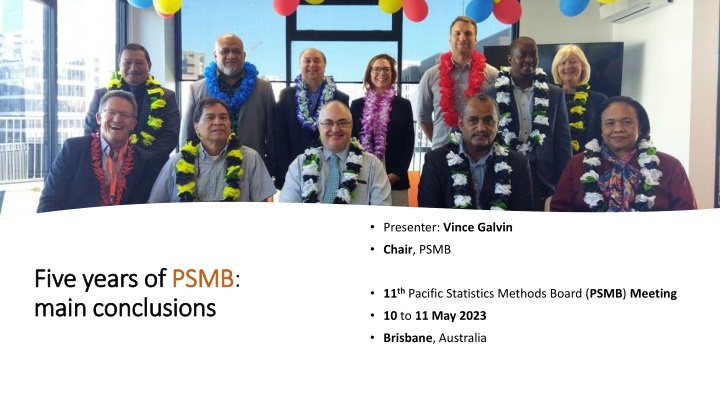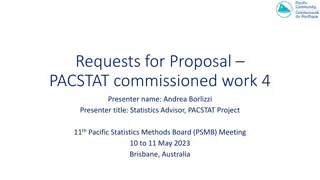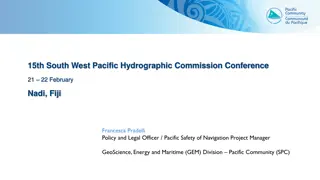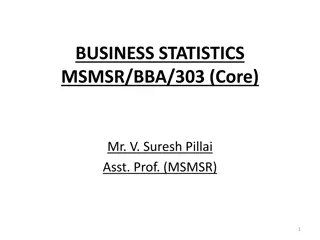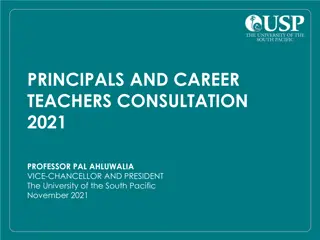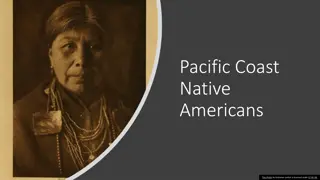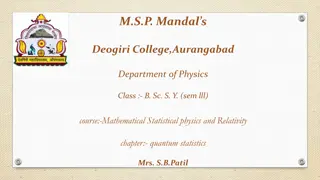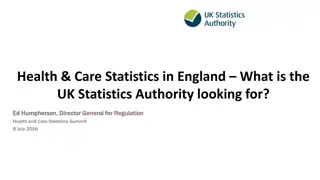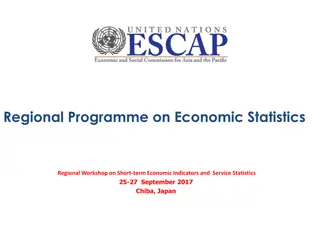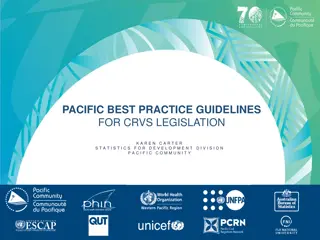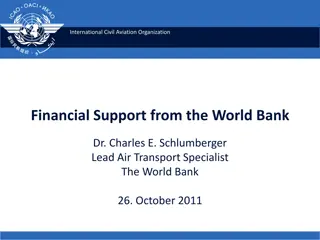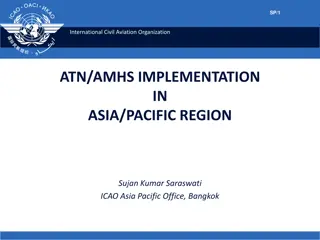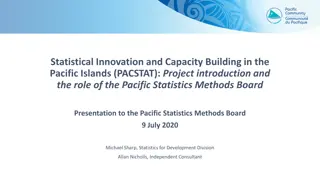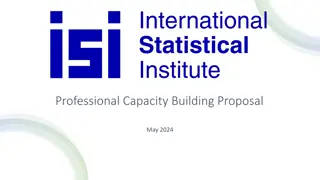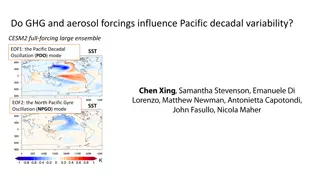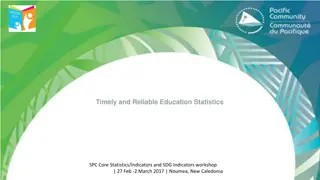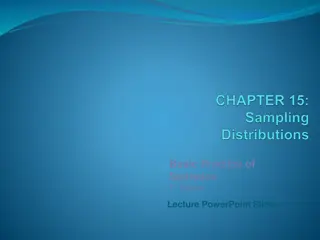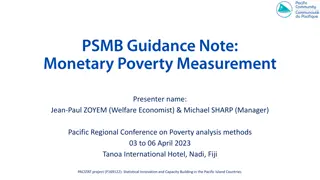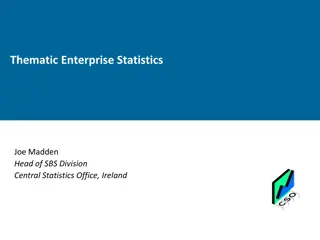Pacific Statistics Methods Board Meeting Conclusions
The Pacific Statistics Methods Board convened for its 11th meeting in Brisbane, Australia, discussing key priorities such as optimizing household data collections and addressing emerging issues in the Pacific region. The meeting saw discussions on sampling methods, poverty measurement approaches, and the endorsement of best practices. Updates on participants and changes along the way were highlighted, reflecting the ongoing evolution of the Board's work.
Download Presentation

Please find below an Image/Link to download the presentation.
The content on the website is provided AS IS for your information and personal use only. It may not be sold, licensed, or shared on other websites without obtaining consent from the author.If you encounter any issues during the download, it is possible that the publisher has removed the file from their server.
You are allowed to download the files provided on this website for personal or commercial use, subject to the condition that they are used lawfully. All files are the property of their respective owners.
The content on the website is provided AS IS for your information and personal use only. It may not be sold, licensed, or shared on other websites without obtaining consent from the author.
E N D
Presentation Transcript
Presenter: Vince Galvin Chair, PSMB Five years of Five years of PSMB main conclusions main conclusions PSMB: 11thPacific Statistics Methods Board (PSMB) Meeting 10 to 11 May 2023 Brisbane, Australia
May 2018. 1stPSMB Meeting Auckland, NZ Inaugural meeting held at the Auckland Office of Stats.
The inaugural meeting Participants: Chairperson, Mr Vince Galvin, Stats NZ; GS of Fiji, Guam, Tonga and Niue; Representatives of ABS, SPC, UN and the World Bank. Prof. Gordon from Bristol University (Consensual Approach). Election of deputy chairperson: Mr Epeli Waqavonovono Terms of Reference (TOR) The Board endorsed the draft TOR (pending the incorporation of amendments relating to the scope of work, consistent terms for the posts of Chairperson and Deputy Chairperson, and representation of subregions). Immediate priorities for PSMB Optimize the programme of household collections for countries; Identify issues of concern and emerging issues that are strategically significant for the Melanesia, Micronesia, Polynesia and SIS groups through dialogue with GS; Increase transparency through documentation of data processing and cleaning processes.
Changes along the way Participants: Chairperson, Mr Vince Galvin, Stats NZ; GS of Fiji, Guam, Tonga and Niue; Representatives of ABS, SPC (now stats), UN and the World Bank. Lost Guam, the other GS s have changed (especially Fiji !!!), Ofa, Epeli and Maria found different hats to wear !! Election of deputy chairperson: Mr Epeli Waqavonovono, Dr Villiami Fafita, Leota Aliielua Salani Terms of Reference (TOR) Updated the Terms of Reference. Look ahead further !!! Immediate priorities for PSMB Its really up to us !!!!!!!!!
Endorsements Endorsement of the sampling sub-committee TOR and review of the sampling guidelines RMI HIES experiment The use of the recall method (versus diary) has not negative implications for data quality and user requirements, including those for CPI, national accounts, poverty and nutrition analysis. low-monitored diaries yield inferior data quality compared to the recall method; the cost of recall is markedly lower than the cost of a highly monitored diary. in light of the cost savings, and the consistency and quality of data generated through use of recall in the RMI HIES experiment, PICTs are recommended to consider the option of shifting from diary to recall-based methodologies for the collection of consumption data. 2. Approaches to monetary Poverty Measurement WB recommendations were accepted as universal best practice; among them: SDG 1.1.1 should be measured using the USD 1.90 PPP per capita per day International Poverty Line. SDG 1.2.1 should be measured using a national cost-of-basic-needs poverty line based on national survey data and national criteria. Food consumption should include purchases (including prepared meals and food consumed away from home), gifts received, food provided in-kind, home production, and rations. Non-food consumption should include the use value of assets, imputed rent, education spending, health spending on preventative and elective procedures, but exclude lumpy expenditures, investment, loans, interest, taxes, and transfers out of the household. Countries should continue to use the current per adult equivalence scale instead of per capita measures to adjust the consumption aggregate for household composition Imputed rents should be calculated accounting for local price differences and compensate for owners tendencies to overvalue their dwelling. All data cleaning and calculations should be done using replicable methods in a statistical analysis program such as Stata or R.
July 2020 5thPSMB Meeting Online Online WB-IDA PACSTAT Project Poverty guidelines Labour Market Module in PHC Use of administrative databases in PHC
Endorsements / Discussed The PACSTAT Project To improve the quality of welfare data collection and accessibility to comparable welfare data in Pacific Island countries through activities under 3 components: Support to the Pacific Statistics Methods Board; Institutional strengthening and implementation support; and Alternative data collection methods; High Frequency Phone Monitoring (HFPM) Surveys Endorsed in principle the proposal to test the HFPM survey method in experimental research on alternative data collection methods under the IDA project. Who can forget Mr P !!!! Pacific road map to increase use of registers or administrative data in census SPC leading the project Utilisation of registers and administrative data in census programmes for Pacific Island countries .
Endorsements / Discussed Guidelines for monetary poverty agreed to the interim adoption of the guidelines for monetary poverty analysis, pending further analysis and discussion (at the next PSMB meeting) of specific unresolved issues, including: dietary energy values, the use of spatial price deflators or subregional poverty lines, calculation of imputed rents, the method of calculating adult equivalents, and the estimation of non-food components of poverty Labour Market Module in Pacific Population and Housing Census successful pilot of a new module on the economic characteristics of the population, developed jointly by the ILO and SPC, in the 2020 Kiribati census pilot; ILO and SPC to update the census module by making the proposed minor revisions to address issues identified by the pilot; PICT NSOs are encouraged to include the validated ILO-SPC census module on economic characteristics in their upcoming population and housing census; UNFPA and other international partners are exhorted to promote the use of the ILO-SPC census module as part of the 2020 round of Population and Housing Censuses.
Endorsements /Discussed PACSTAT: First PSMB Commissioned Work drafted TOR for a consultancy to undertake a Methodological review for anonymising census and survey microdata in the context of small island developing states . Report 1: Improving access to and use of Pacific development microdata; Report 2: A practical guide for anonymising census and survey microdata PACSTAT Microdata access consultancy Prof. W. Narsey PSMB agreed on the need to respect data sovereignty and supported exploring a tiered approach, e.g. Tier 1, open access; Tier 2, lower access; Tier 3, restricted. Four proposals for statistical research and innovative experiments received: Survey module on household impacts of climate change; HIES modules on food away from home ; Inclusion of depreciation of public capital stock in national accounts; and Dashboard to monitor economic recovery from COVID impact). Guidance notes Plans to produce a series of practical guidance notes for NSOs in 2022, with topics to include: microdata dissemination; the HIES experiment RMI and resulting recommendations; Sampling; Poverty measurement; and administrative data.
Endorsements / Discussed MICS Plus PSMB endorsed UNICEF s conduct of MICS Plus in PICTs, noting it had previously endorsed MICS. Asian Development Bank (ADB) projects Strengthening economic statistics for measuring progress toward sustainable development goals. Strengthening digital information of national statistical data systems Data for development (Phase 2): Agricultural Statistics/Sampling Component
Endorsements / Discussed PACSTAT Methodological review for maximising the dissemination and use of microdata in the context of Small Island Developing States draft report History of microdata in the Pacific and its use. PICTs lagging behind other comparable developing countries globally in the openness of development data indicators in general and use and access to microdata in particular. PICT NSOs asked to respond to a questionnaire NSOs want more evidence-based reports and policy recommendations based on their microdata, and more work on anonymisation. Several PICTs need to update their legislation relating to data sharing. There is no standard practice in PICTs for microdata storage. Challenges, issues and lessons learned in conducting a census in a COVID-19 environment Samoa PHC 2021 The national ID project will be supported by census information. Improved civil registration a new system is being introduced. Street naming address project the Bureau of Statistics will work with this project, which will reduce census costs and the burden on respondents.
Endorsements / Discussed PACSTAT Microdata dissemination. Conserving all PICT datasets in the PDH-ML using a 4-tier process that recognises PICTs ownership of their data and their concerns with data confidentiality: Tier 1 Secure archiving of all PICT microdata with the PDH-ML, with no access except as approved according to Tiers 2, 3 and 4. Tier 2 PICTs make microdata available to SDD for a short-term project for analysis and reporting on topics prioritised by NSOs (e.g. food security, poverty). Tier 3 PICT NSOs decide whether to make microdata sets available to researchers who apply for access, with PDH-ML coordinating the approval process for the PICT that owns the data. Tier 4 PICT NSOs make microdata sets freely available, with strict conditions set down for terms of use. Methodological review for collection of data on the impact of climate change, using household surveys. PSMB: i. supported the development of the first draft of the Climate Change and Natural Disasters Survey Module and a model questionnaire source book to assist governments in collecting information and identifying priorities for addressing climate change and natural disasters; ii. PICTs will be consulted on the draft of the module and there will be country testing of the type of questions to ask before planning the roll-out of the module. Samoa Food away from Home (FAFH) experiment. PSMB was interested in the innovative approach to estimating FAFH and the cost of calories for FAFH, including using crowd sourcing and a social media campaign to build a food database, noting the database may be adaptable for similar projects in other PICTs.
Endorsements / discussed 3. PACSTAT Review and endorsement of PSMB guidance note on monetary poverty measurement eight recommendations for measuring monetary poverty, including: 1. using the International Poverty Line to measure SDG 1.1.1, and the national cost-of-basic-needs poverty line to measure SDG 1.2.1; 2. what should be included in food consumption; 3. what should be included in non-food consumption; 4. calculating imputed rent; 5. using the OECD per adult equivalent to adjust the consumption aggregate for household composition. Tuvalu long form census Project to integrate a HIES survey with the census, given there are many overlapping questions. The idea is to get a HIES for free with reduced costs for planning and enumerator training, and less burden on households. Disadvantages include the issue of seasonality, which affects production and prices, and the length of the questionnaire for the HIES households. However, the advantages outweigh the disadvantages. Vanuatu NSO proposal: Modernising official statistics data science driving innovation in climate change and natural disasters The PACSTAT Committee decided to invest in the project, which will investigate reproducible analytical pipelines (RAPs), machine learning (ML), and an information management system with the aim of automatically estimating the damage from a disaster and the resources needed for immediate response, and improving the efficiency of data collection.
Discussed Use of administrative data in PICTs - Stats NZ s experimental administrative population census testing the use of administrative data instead of traditional census data collection, with a view to informing future census models; evaluating the data and methods used, and whether data needs are met. NSO software use The software landscape is complex, with NSO choices frequently linked to the technical support available from SPC, UNICEF and other agencies. PSMB was invited to recommend: 1. that the statistical software used by NSOs should facilitate the implementation of common methods to standardise official statistics; 2. statistical software functionality should match the evolving needs of data users (timeliness); 3. a capacity assessment of regional Pacific statistical systems. NSO and UNFPA work on population data in PNG
Main Types of Value Provided a place to discuss issues of significance. In practice we have talked about Poverty Measurement. Experts in Consensual Approach and Monetary Measurement approach have taken us through detailed explanations. Guidance notes aim to give countries the benefit of these experts, but this needs to be kept under review. Provided a place to discuss the merits and limitations of some great pieces of pilot / experimental work which have informed practice RMI HIES TEST (using CAPI and recall method versus diary) ENDORSE, IN PRINCIPLE, THE HIGH FREQUENCY PHONE MONITORING SURVEYS (HFPM) TO HELP PACIFIC COUNTRIES ASSESS THE SOCIO-ECONOMIC IMPACT OF COVID19 REVIEW SHORT LABOUR FORCE MODULE FOR INCLUSION IN THE POPULATION CENSUS
Main Types of Value Responded to initial concerns about efficiency of Household Survey sampling with a document, and a great workshop (model) This was a lot of work and we were not sure we had hit the spot Provided partners, UN agencies in particular with a forum in which to discuss their approach in the Pacific FEEDBACK ON THE FIRST INTRODUCTION OF THE UNICEF-MULTIPLE INDICATORS CLUSTER SURVEY (MICS) Discussion with ADB Facilitated, helped create an environment that enabled PACSTAT to come into existence. Some good quality work has been produced under this mechanism. Approach to admin data roadmap Microdata guidelines Environmental Impact module
Work Ons Communication of the material provided to and generated by the Board. We have had material and discussions worthy of any international conference Representation structure of the board. Not only a PSMB problem but it still feels like an issue. The Guidance notes feel like the right idea but we are still learning how to make them valuable. Integrating the work of the PSMB with all the resources that SPC has generated to provide the complete service offering It would be great to see our Guidance Notes and other commissioned material in the context of all the other resources SPC has on its website. Role questions people want standards until they really can t implement them and frankly this Board isn t really accountable enough to impose standards on reluctant sovereign states. Had useful discussions with some donor agencies but should we try and force the issue on technical rationalisation more often.
New Possible Directions More actively scan international developments for ideas that might be transferred/ adapted into the Pacific. Double down on something like administrative data enablement and work through roadmaps , tools etc. Map out a sequence of work to develop a toolkit The climate change modules look like first cab off the rank. Had a foray into software and tools this could be difficult but it is a major enabler of an NSO and there are frequent complaints of unhelpful diversity that appears to be largely accidents of history. Focus on advocacy for how to make international standards more appropriate for the Pacific. Work to identify a feasible target state for the Small Island States. Work to establish some support networks of people with specialist skills (like Methods people) with ABS and Stats NZ staff. Especially leverage off ABS infrastructure.
Manage a Research Agenda What are the research priorities for the future? Population-based registers? Resident enumerators? Intra-household dynamics? (allocation, distribution ) Seasonality? Sensor Measurement of the Environment ? Validity of Assumptions underpinning Poverty Measurement ? From 2023 Regional Conference (Nadi) Developing methods for automatic field checks? Supplementary modules? (migrant workers; own-use production; etc.)
